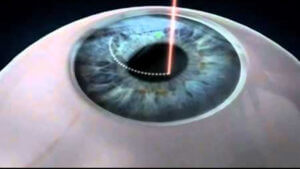How Does Laser Eye Surgery Correct Refractive Errors?

For many people, Laser Eye Surgery still remains a rather scary concept. But a lot of people also don’t realise that Laser Eye Surgery has now been around for a long time – around four decades, in fact. In this time, the technology used and our understanding of the process has continuously evolved, making Laser Eye Surgery one of the safest and most common elective procedures in the world.
Nonetheless, the general basis of Laser Eye Surgery remains much the same as when it was first developed in the 1980s. So, how does Laser Eye Surgery work and how does it correct common refractive errors?
The General Theory of Laser Eye Surgery
In the grand timeline of medical research, Laser Eye Surgery is still one of the new kids on the block. But the origins of this life-changing procedure date back further than most people realise. In fact, the theory still used today dates back to 1948, when Spanish ophthalmologist José Ignacio Barraquer Moner sought a better alternative to external visual aids.
The general basis of Laser Refractive Surgery is the process of reshaping the cornea to change the way light is refracted into the eye. It can now be used to address common refractive errors, including hyperopia, myopia, astigmatism, and presbyopia. Consistent development and innovation have turned Laser Eye Surgery into the most common elective procedure in the world.
What is Laser Eye Surgery?
Laser Eye Surgery is a kind of refractive surgery – that is, one of many operations that corrects the focusing power of the eye. As mentioned above, the procedure is based on the long-accepted theory that changing the way in which light enters the cornea can improve refractive errors. This theory was proven correct by the development of glasses and contact lenses – but Laser Eye Surgery takes things a step further.
Instead of changing the course of light with exterior visual aids, Laser Eye Surgery allows surgeons to change the shape of the eye itself. Using a state-of-the-art, ultra-precise excimer laser, Laser Eye surgeons are able to adjust the curvature of the cornea (the transparent part at the front of the eye that covers the pupil and iris). This allows light to be focused correctly onto the retina at the back of the eye.
The first Laser Eye Surgery procedure was introduced in 1987. This early iteration of the procedure is called Photorefractive Keratectomy (PRK) – a surface procedure rarely used today.
That brings us to the different types of Laser Eye Surgery. While browsing the internet and different clinics can leave you with the impression that there are countless kinds of Laser Eye Surgery to choose from, the fact is, there are only really three types that you need to worry about: PRK/LASEK, LASIK, and ReLEx SMILE.
PRK and LASEK – The Surface Procedures
Surface procedures involve the complete removal of the corneal epithelium (a thin layer of tissue on the surface of the eye) using an XMR laser. This allows surgeons to access the stromal tissue beneath and change the shape of the cornea.
In PRK, the thin layer of the epithelium is removed and discarded.
Following the successful adjustment to the cornea, a protective contact lens is then placed over the exposed area of the eye. This lens protects the eye until the epithelium has repopulated. This usually takes a matter of days.
LASEK, though also a surface procedure, is not considered as invasive as PRK. That’s because, after the epithelium has been removed, it is simply pushed to one side ready to be put back in place once the corneal adjustment has been completed. A protective contact lens is again placed over the affected area of the eye.
While PRK/LASEK procedures still yield great results, they are now only used when either LASIK or SMILE treatments are not suitable.
LASIK – The Most Popular
Today, LASIK (laser in-situ keratomileusis) is the most popular type of Laser Eye Surgery procedure carried out around the world. Unlike its predecessors, LASIK does not require the removal of the epithelium from the surface of the eye, making it a less invasive option. Instead, the surgeon creates a ‘flap’ on the surface of the eye to gain access to the tissue underneath.
Once the re-shaping procedure has been successfully completed, this flap can simply be closed, once again covering the exposed area of the eye. Once this flap has been closed, the cornea immediately begins to adapt to its new shape and – thanks to the less invasive procedure – healing times are significantly reduced.
ReLEx SMILE – The Most Innovative
Finally, ReLEx SMILE (also called SMILE) is the newest and least invasive Laser Eye Surgery procedure. SMILE (small incision lenticule extraction) is a keyhole procedure that does not require the removal of the epithelium to any degree. Instead, a femtosecond laser is used to create a tiny tunnel from the surface of the eye to the corneal tissue beneath the epithelium.
Through this tunnel, the surgeon is then able to use the ultra-precise Carl Zeiss VisuMax laser to draw out a small amount of tissue to reshape the cornea. The development of SMILE has opened Laser Eye Surgery to more people than ever before. The minimally-invasive procedure is able to treat even higher prescriptions than was previously thought possible, and it is often suitable for patients with drier eyes or thinner corneas.
If you would like to learn more about how Laser Eye Surgery could improve your vision, get in touch with one of our friendly clinic coordinators. Alternatively, Book a Consultation today.


